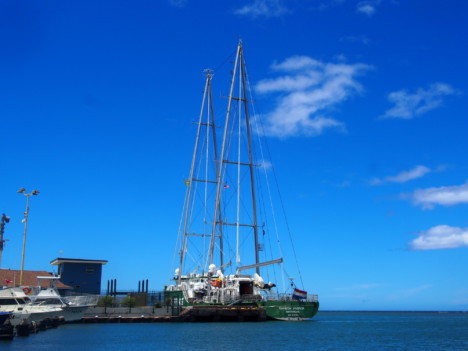Greenpeace Vessel Visits Molokai
By Jack Kiyonaga | Editor

Photo by Jack Kiyonaga.
Molokai had a notable visitor last week: the Rainbow Warrior and its Greenpeace crew. The 160-foot tall, and 200-foot long ship docked at Kaunakakai Wharf from Tuesday, Sept. 3 until Thursday, Sept. 5, giving time for residents to explore its decks and meet with the crew, as well as for Greenpeace to visit several Molokai sites.
Greenpeace, a massive international advocacy nonprofit focused on environmental and political activism, landed in Hawaii following a campaign in the Emperor Seamount Chain just north of the Hawaiian Islands.
The Greenpeace crew first spent time in Lahaina working on stream restoration, resource management and mapping where fruit trees once stood previous to the 2023 Lahaina fires, before crossing the channel to Molokai.
“Molokai was highlighted to us as a place where [resource management] is really working well,” explained Arlo Hemphill, Greenpeace’s U.S. project lead for Ocean Sanctuaries and Stop Deep Sea Mining.
The Greenpeace crew was able to stop at important Molokai locations like Keawanui Fishpond and Mo’omomi to hear more about Native Hawaiian practices regarding responsible land and ocean resource management.
“We’re excited to learn,” explained Hemphill, especially about the concept of mauka to makai and how Native Hawaiians have viewed ocean and land interaction as one ecosystem.
And while Greenpeace has been historically more focused on ocean-pertaining issues, “we’re learning that taking care of the land is part of taking care of the ocean,” said Hemphill.
Greenpeace invited the Molokai community aboard the Rainbow Warrior for a dinner followed by a screening of a film detailing the bombing of the first Rainbow Warrior ship back in 1985.
“We don’t always get to do these intimate gatherings with communities,” said Katie Nelson, senior communications specialist for Greenpeace. “It’s really cool to get to have these smaller community gatherings.”
The film highlighted Greenpeace’s activism in the South Pacific in the 1970s and 80s as they protested the testing of atmospheric nuclear bombs by governments like the U.S. and France. In response, French espionage agents blew up the first Rainbow Warrior in 1985 while it was docked in Auckland, New Zealand – killing one Greenpeace crew member in the process.
This history connected with Molokai’s own legacy of activism. Before the film screening, well known Molokai activist Walter Ritte presented the captain of the Rainbow Warrior with a copy Na Mana’o Aloha o Kaho’olawe. The book details the Kaho’olawe Nine, of which Ritte was a part, and their protest of the bombing of Kaho’olawe by the U.S. government.
“We were aware of the history” of Molokai activism, said Hemphill. “These are people fighting for things that we have shared values with…We want to stand alongside and be allies with them”
After their visit to Molokai, the Rainbow Warrior and crew headed to Honolulu to continue their outreach campaign, before sailing to Hong Kong on Sept. 12.











Don't have a Molokai Dispatch ID?
Sign up is easy. Sign up now
You must login to post a comment.
Lost Password